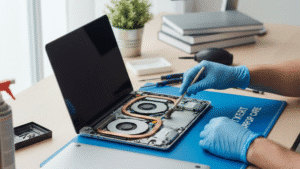Imagine you’re working on an assignment, drafting an important email, or even gaming for fun — and suddenly one letter on your laptop keyboard gets stuck. Before you know it, the screen fills up with a long trail of repeated characters you never typed. It’s frustrating, disruptive, and often confusing if you don’t know why it’s happening.
This issue may look like a small annoyance at first, but ignoring it can turn into something more serious. Left unchecked, it can damage productivity, cost you more in the long run, or even make your device unusable for work or study. In some cases, it ends up requiring professional laptop repair to bring your device back to life.
This guide will walk you through why keys get stuck, what you can try at home, when it’s time to call in experts, and how to stop it from happening again.
What Causes the Issue
Keyboard issues are surprisingly common, but repeated key presses can leave many users scratching their heads. The reality is that this problem usually falls into one of a few categories.
Dust and Debris Under the Keys
Every day life leaves crumbs, dust, and pet hair lurking inside your keyboard. Even a small piece of debris can make a key appear pressed down or jammed, causing it to repeat endlessly. This is especially true for laptops used in cafés, libraries, or around kids and pets.
Software and Driver Glitches
Sometimes the culprit isn’t physical at all. Corrupt drivers or glitchy updates can send the wrong signals to your operating system. Accessibility features like Sticky Keys or Filter Keys may also accidentally trigger repeated input if they’re enabled.
Hardware Wear and Tear
Over time, laptop keyboards naturally degrade. The thin plastic membranes under each key can lose their elasticity, and ribbon cables may loosen with repeated use. Heavily used keys like Enter, Spacebar, and Backspace are often the first to show signs of wear.
Electrical or Motherboard Faults
While rare, deeper hardware issues can also cause repeating keys. Problems with the keyboard controller chip or even the motherboard can misinterpret signals, making it seem like a key is being pressed repeatedly.
Easy Fixes to Try at Home
Before panicking or rushing to book an appointment, it’s worth trying a few safe and simple fixes. These won’t cost you anything and often solve the problem quickly.
Restarting the System
It sounds obvious, but a system restart is often the quickest solution. Temporary glitches in memory or background software can sometimes trigger repeated key presses, and a reboot clears them out.
Cleaning the Keyboard Safely
If dirt or dust is to blame, a quick clean might do the trick. Use a can of compressed air to blow debris out from under the keys. For sticky spills, gently dab the affected key with a cotton swab lightly dipped in isopropyl alcohol. The key is to avoid over-saturating the area — a light touch goes a long way.
Checking System Settings
Operating systems often have accessibility features that affect how your keyboard responds. On Windows, for example, Sticky Keys and Filter Keys can alter input. Disabling or adjusting these can sometimes fix repeated key issues. Updating or reinstalling your keyboard drivers is another step worth trying.
Testing with an External Keyboard
One of the simplest ways to diagnose the issue is by plugging in an external keyboard. If the external one works perfectly, the problem likely lies in your laptop’s hardware. If the same issue persists, the root cause is more likely software-related.
Signs You Need Expert Help
While DIY fixes are a good starting point, some problems go beyond what you can handle at home. Recognising when it’s time to seek help can save you frustration and prevent further damage.
When Multiple Keys Are Affected
If more than one key is repeating, you’re likely dealing with a larger issue. This often points to a failing keyboard membrane or ribbon cable, both of which require professional tools to fix.
If the Problem Shows Outside the OS
Does the key repeat even in the BIOS menu or during boot-up? If so, the problem isn’t with your operating system but with the hardware itself — something you can’t fix through software tweaks.
Persistent Issues After Cleaning
If you’ve cleaned, updated drivers, and restarted multiple times but the issue keeps coming back, it’s time to stop guessing. A technician can save you the trial-and-error headache and get to the root cause faster.For those dealing with persistent issues, seeking an HP laptop repair service can provide specialised support for hardware faults and ensure your device is restored properly.
How Professionals Handle the Repair
Professional repair services approach the problem in ways most home users can’t replicate. Their tools, training, and access to replacement parts make them uniquely equipped to solve stubborn keyboard issues.
Diagnostic Software and Tools
Technicians use diagnostic software that tests each key’s responsiveness and identifies whether the problem lies in the keyboard, connector, or system.
Checking Ribbon Cables and Connectors
Loose or damaged ribbon cables are a common culprit. Professionals carefully open the device, reseat or replace the cable, and ensure the connectors are properly aligned.
Replacing the Keyboard Unit
In many cases, replacing the entire keyboard is the most efficient solution. It may sound drastic, but it’s often cost-effective and guarantees long-term reliability.
Firmware and BIOS Adjustments
Sometimes the fix lies not in the hardware but in the system software. Updating or resetting the BIOS can resolve miscommunications between the laptop and its keyboard.
When comparing options, some people search for the best phone repair shop in Adelaide, but laptop keyboards often need more specialised attention than general electronics repair services can provide. Choosing a professional who understands laptop internals is essential for lasting results.
Preventing the Issue in the Future
Once your keyboard is back in working order, prevention is key. A few simple habits can greatly extend the life of your laptop and keep you typing smoothly.
Regular Cleaning Habits
Dust your keyboard weekly with a soft brush or compressed air. It’s a small effort that prevents debris from building up.
Using a Keyboard Protector
A silicone keyboard cover acts as a barrier against dust, crumbs, and liquid spills. It’s an inexpensive accessory that saves you from costly repairs down the line.
Being Mindful of Food and Drinks
Eating over your laptop is risky business. A single spill can cause a world of damage, not just repeated keys. Keeping food and drinks away is a simple but effective preventative measure.
Gentle Typing Practices
Laptop keyboards are designed for light touches. Heavy-handed typing puts unnecessary strain on the delicate mechanisms and shortens their lifespan.
DIY vs Professional Help
It’s tempting to keep trying new DIY fixes, but knowing when to step back is just as important as knowing what to try.
What You Can Safely Do Yourself
Restarting, cleaning, updating drivers, and testing with an external keyboard are all low-risk, practical steps you can take on your own.
Situations Where a Technician Is Essential
If the problem persists after multiple DIY attempts, or if multiple keys are affected, it’s time to see a professional. Experts provide not just repairs but also warranties, giving you peace of mind that the problem won’t return.
Conclusion
A repeating laptop key can take the joy out of even the simplest tasks, but it’s far from hopeless. From quick DIY fixes like cleaning and driver updates to expert solutions that replace faulty components, there are plenty of ways to restore your device. The key is knowing when you can handle it yourself and when it’s time to trust an expert.
The sooner you act, the less frustration you’ll face — and the more money you’ll save in the long run. With professional help, your laptop can feel as good as new and keep supporting your work, study, and leisure without interruptions.For those looking for a trusted name in device repairs, digimob is a strong choice, offering reliable solutions and professional service to get your laptop back on track.



